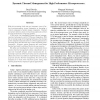Free Online Productivity Tools
i2Speak
i2Symbol
i2OCR
iTex2Img
iWeb2Print
iWeb2Shot
i2Type
iPdf2Split
iPdf2Merge
i2Bopomofo
i2Arabic
i2Style
i2Image
i2PDF
iLatex2Rtf
Sci2ools
111
click to vote
HPCA
2001
IEEE
2001
IEEE
Dynamic Thermal Management for High-Performance Microprocessors
With the increasing clock rate and transistor count of today's microprocessors, power dissipation is becoming a critical component of system design complexity. Thermal and power-delivery issues are becoming especially critical for high-performance computing systems. In this work, we investigate dynamic thermal management as a technique to control CPU power dissipation. With the increasing usage of clock gating techniques, the average power dissipation typically seen by common applications is becoming much less than the chip's rated maximum power dissipation. However, system designers still must design thermal heat sinks to withstand the worst-case scenario. We define and investigate the major components of any dynamic thermal management scheme. Specifically we explore the tradeoffs between several mechanisms for responding to periods of thermal trauma and we consider the effects of hardware and software implementations. With appropriate dynamic thermal management, the CPU ca...
Computer Architecture | CPU Power Dissipation | Dynamic Thermal Management | HPCA 2001 | Maximum Power Dissipation |
Related Content
| Added | 01 Dec 2009 |
| Updated | 01 Dec 2009 |
| Type | Conference |
| Year | 2001 |
| Where | HPCA |
| Authors | David Brooks, Margaret Martonosi |
Comments (0)

